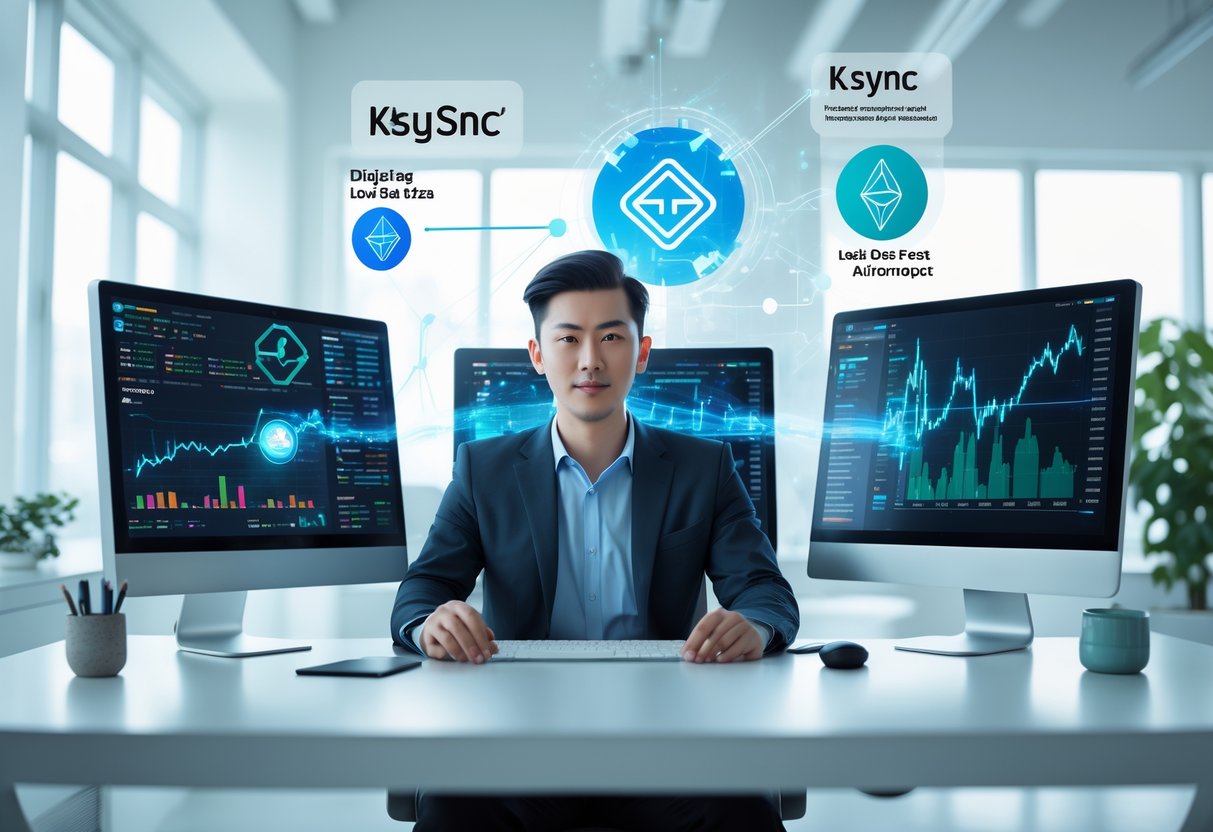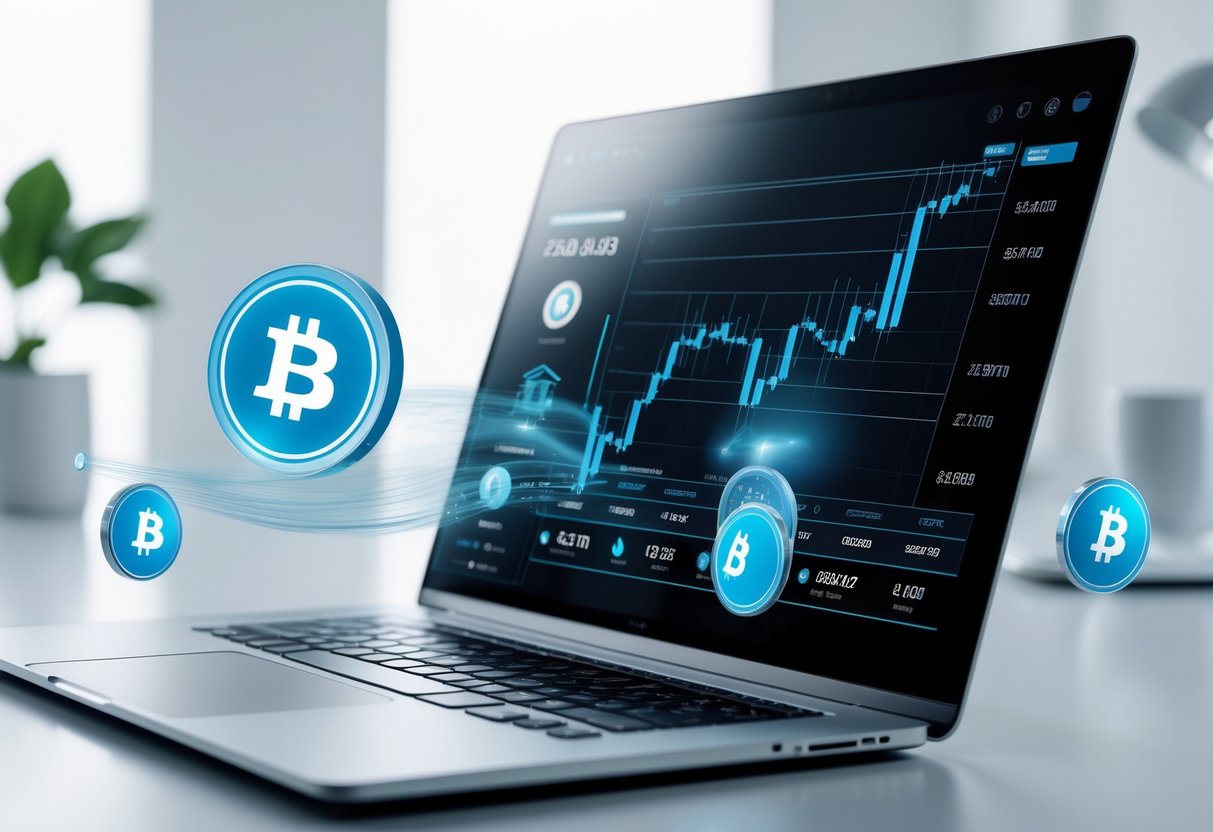
ZkSync airdrops offer crypto enthusiasts a chance to earn tokens while benefiting from low fees and scalable technology. This layer-2 solution built on Ethereum uses zero-knowledge proofs to address high gas fees and network congestion problems that plague many blockchain networks. By farming zkSync airdrops, users can potentially receive valuable tokens while enjoying transaction costs that are just a fraction of those on the Ethereum mainnet.

See Rewards Linked to This Topic—Follow Steps to Get:
Great news—exclusive perks are just a few steps away! Follow these simple actions to unlock bonuses linked to this topic!
How It Works (Fast & Easy!)
1️⃣ Check Your Rewards in Seconds
→ Click Here to See How Much You Qualify For (No commitment!)
First-time withdraw can unlock 7K+ USD.
2️⃣ Connect Your Wallet
Use any mobile or desktop wallet (MetaMask, Trust Wallet, etc.)—approved in seconds!
3️⃣ Cash in Your Pocket in 15 Minutes!
Get your funds fast—no credit checks, no waiting.
Why This is a Game-Changer 💎
✔ Each month there is a free offer reward for all users.
🔥 Limited-Time Offer – Claim Your $7K+ Now!
👉 Get Instant Access Here
No hidden fees. No credit checks. Just fast cash against your crypto! – and this is not a financial advice.
Airdrop farming on zkSync involves interacting with various protocols in the ecosystem to establish activity that might qualify for future token distributions. The network provides fast confirmation times and high throughput, making it cost-effective to perform multiple transactions without breaking the bank. Users can bridge assets from Ethereum, swap tokens, provide liquidity, or use dApps built on zkSync to demonstrate engagement.
The zkSync ecosystem continues to grow with more applications being built on its zk technology foundation. For those looking to position themselves for potential airdrops, now is an excellent time to start establishing a history of network usage. Many projects follow similar qualification patterns, typically rewarding active users who have demonstrated consistent engagement rather than those who simply make a single transaction.
Understanding zkSync and Layer-2 Advantages

zkSync offers a powerful solution to Ethereum’s scaling challenges through zero-knowledge rollup technology. This innovative approach drastically reduces fees while maintaining security and improving transaction speeds for users looking to participate in the ecosystem.
What Is zkSync and How Does It Work
zkSync is a Layer-2 scaling solution built on Ethereum that uses zero-knowledge proofs to process transactions off the main chain. It bundles multiple transactions together and generates cryptographic proofs to verify their validity.
The system works by processing transactions on a separate chain, then posting only the proof and compressed data to Ethereum. This approach significantly reduces the amount of data stored on the main blockchain.
Users can deposit ETH and other tokens from Ethereum into zkSync, use them with low fees, and withdraw back to the main network whenever needed. The zero-knowledge proofs ensure that all transactions follow Ethereum’s rules without requiring every node to process each transaction.
Layer-2 Scaling Solutions and Ethereum Scaling
Layer-2 scaling solutions address Ethereum’s limitations in transaction throughput and high gas fees. These solutions process transactions off the main chain while inheriting Ethereum’s security.
Unlike sidechains that have their own security models, Layer-2 solutions like zkSync rely on Ethereum for final settlement. This approach maintains decentralization while improving scalability.
Several Layer-2 solutions exist, but zkSync’s zero-knowledge rollups offer advantages over optimistic rollups by eliminating long withdrawal waiting periods. With Ethereum handling only verification of proofs rather than full transaction data, the network can process many more transactions per second.
Key Features of zkSync Era and zkSync Lite
zkSync comes in two main versions: zkSync Lite and zkSync Era. Lite focuses on simple token transfers and swaps with minimal features but extremely low fees. Era expands functionality to support smart contracts and more complex applications.
Key features include:
- Transaction fees up to 100x lower than Ethereum mainnet
- Fast confirmation times (usually under 2 minutes)
- Native support for ETH and ERC-20 tokens
- Compatibility with existing Ethereum wallets
- Strong security inherited from Ethereum
zkSync Era supports Solidity smart contracts, making it easy for developers to deploy their applications with minimal changes. This compatibility has led to a growing ecosystem of decentralized apps on zkSync.
Both versions maintain decentralization while providing the scalability benefits that make Layer-2 solutions attractive for airdrop farming with minimal costs.
Getting Started: Bridging Assets and Reducing Gas Fees

Moving your assets to zkSync requires understanding how to bridge effectively while minimizing gas fees. The right approach can save you significant money while positioning you for potential airdrop opportunities.
Using Bridges to Move Funds to zkSync
Bridging assets to zkSync Era gives you access to faster transactions and lower fees compared to Ethereum mainnet. The most direct option is the official zkSync bridge, which connects directly to the zkSync mainnet. This native bridge provides a secure pathway for moving ETH and other tokens.
For those concerned about high gas fees, several alternatives exist. Layerswap offers competitive rates and supports multiple exchanges as sources. Orbiter.finance specializes in quick transfers with minimal fees. Rhino.fi (formerly DeversiFi) provides a user-friendly interface for bridging.
When bridging funds, timing matters. Gas fees on Ethereum fluctuate throughout the day. Weekends and late nights (UTC time) often have lower network congestion, resulting in cheaper transactions.
Step-by-Step Bridging with Official Bridge and Third-Party Services
To bridge using the official zkSync bridge:
- Connect your MetaMask or other compatible wallet
- Visit bridge.zksync.io
- Select the token you want to bridge (ETH is recommended for beginners)
- Enter the amount
- Approve the transaction and confirm the gas fee
- Wait for confirmation (typically 5-15 minutes)
Third-party services like Across can offer lower fees in some cases:
- Visit across.to
- Connect your wallet
- Select Ethereum as source and zkSync as destination
- Enter amount and complete the transaction
Compare fees before bridging. Some services charge lower percentages but have higher minimum amounts. For small transfers under $100, Owlto often provides the most cost-effective option.
Choosing the Right Wallets and Security Practices
MetaMask remains the most popular wallet for interacting with zkSync, offering solid security and wide compatibility. Make sure your MetaMask is updated before attempting to bridge assets.
Security should never be compromised when bridging. Always:
- Double-check destination addresses
- Start with small test transactions
- Never share private keys or seed phrases
- Enable two-factor authentication where available
- Verify website URLs to avoid phishing attacks
Hardware wallets like Ledger provide an extra layer of protection. They can connect to MetaMask while keeping your private keys offline and secure.
When choosing wallets, consider those that natively support zkSync to avoid compatibility issues. Some wallets also offer built-in bridging features that simplify the process and potentially reduce fees.
Farming zkSync Airdrops Efficiently

Farming zkSync airdrops requires strategic engagement with the ecosystem’s various protocols and applications. The most effective approaches involve regular interaction with multiple dApps while keeping gas fees low.
Participating in zkSync Ecosystem DApps
The zkSync ecosystem offers numerous dApps that can help you qualify for potential airdrops. Regular interaction with popular platforms like SyncSwap, Mute, and SpaceFi increases your chances of receiving future token allocations.
Start by connecting your wallet to the zkSync Era network through Chainlist.org. Once connected, explore different dApps across various categories including DeFi, NFTs, and gaming platforms.
Projects like Gitcoin on zkSync allow users to contribute to open-source development, potentially qualifying them for future rewards. Many protocols track user activity and engagement metrics when determining airdrop eligibility.
Consider using the zkSync Name Service to register a domain, as name services have historically been included in airdrop criteria for other Layer 2 networks like Arbitrum.
Swapping and Providing Liquidity on Decentralized Exchanges
Decentralized exchanges on zkSync offer excellent opportunities for airdrop farming with minimal fees. SyncSwap, ZigZag Exchange, and PancakeSwap on zkSync have gained significant traction among users seeking potential airdrops.
Perform regular token swaps between popular assets to establish an active trading history. Even small transactions can help establish your on-chain presence.
Providing liquidity to trading pairs is particularly valuable for airdrop qualification. Look for pools with reasonable APYs to earn passive income while farming for airdrops.
Some exchanges offer liquidity mining programs where you earn additional tokens simply by providing liquidity. These tokens might become valuable in the future or qualify you for further airdrops.
Exploring zkSync Lending and Borrowing Protocols
Lending protocols on zkSync offer another avenue for potential airdrop farming. By supplying assets to lending pools or taking out collateralized loans, users demonstrate deeper engagement with the ecosystem.
Popular lending platforms track user metrics like total value supplied, borrowing activity, and length of participation when considering airdrop eligibility.
Try depositing stablecoins like USDC or DAI into lending protocols, as these typically offer the best risk-adjusted returns while establishing your participation history.
Consider borrowing small amounts against your deposits to show active usage of the protocol’s features. Just be mindful of liquidation risks and borrowing fees.
Regularly interact with the protocol by adjusting your positions or claiming earned interest to maintain an active profile.
Maximizing Airdrop Opportunities with Quests and Social Activity
Airdrop farming on zkSync goes beyond on-chain activity. Many projects offer quests or tasks that users can complete to increase their chances of receiving tokens.
Follow official zkSync social media accounts and join their Discord or Telegram communities. Projects often reward active community members during token distributions.
Participate in testnets, as these early users frequently receive generous allocations. When new protocols launch on zkSync, they often prioritize testnet participants for airdrops.
Look for zkSync ecosystem projects that offer points programs or gamified experiences. These systems typically track your activity and reward engagement.
Consider creating content about zkSync or sharing your experiences with the ecosystem, as some projects allocate tokens to content creators and educators who help grow the community.
Risks, Security, and Best Practices for Low-Fee Airdrop Farming
While ZkSync airdrops offer excellent earning potential with low fees, they come with significant risks that every farmer must understand. Security should always be your top priority when interacting with any blockchain platforms.
Avoiding Crypto Scams and Phishing Attacks
Airdrop farming on ZkSync attracts numerous scammers looking to exploit eager participants. Fake airdrops often promise unrealistic rewards to lure in victims. These scams typically request private keys or seed phrases—information you should never share.
Be wary of messages from “official” support teams on social media or Telegram. Legitimate projects will never ask for your private information or funds to participate in airdrops.
Always verify URLs carefully. Scammers create websites that look identical to official ZkSync platforms but have slightly different domain names. Use bookmarks for official sites rather than clicking links from emails or messages.
Before connecting your wallet to any decentralized application, check the project’s reputation on trusted review sites and community forums.
Protecting Your Wallets and Funds
When farming ZkSync airdrops, consider using a dedicated wallet specifically for airdrop activities. This separation limits potential losses if one wallet becomes compromised.
Essential wallet security practices:
- Use hardware wallets for long-term storage
- Enable two-factor authentication when available
- Create strong, unique passwords
- Never store seed phrases digitally
- Keep wallet software updated
Consider small test transactions before moving larger amounts. Transaction fees on ZkSync are low enough that this precaution costs very little.
Review smart contract permissions regularly. Many users grant unlimited spending approval to protocols, creating security vulnerabilities. Revoke unnecessary permissions through tools like Revoke.cash.
Staying Informed About Token Distribution and Official Announcements
Follow official ZkSync channels for accurate information about airdrops. The official Twitter account, Discord server, and website are primary sources for legitimate announcements.
Set up notification alerts for important updates. Token distribution details often change, and missing an announcement could mean lost opportunities or security risks.
Reliable information sources:
- ZkSync official website
- Verified social media accounts
- Community-trusted news outlets
- Official documentation
Be skeptical of “insider information” about upcoming airdrops. Fraudsters often create false urgency to push victims into hasty decisions.
Check token allocation details carefully before participating. Understanding vesting periods, distribution mechanisms, and eligibility requirements helps you evaluate an airdrop’s legitimacy and potential value.
Frequently Asked Questions
Many users have questions about farming zkSync airdrops efficiently while keeping costs low. These answers provide clear information about eligibility, claiming, and tracking zkSync tokens.
What are the eligibility requirements for receiving a zkSync airdrop?
To qualify for zkSync airdrops, users typically need to actively participate in the zkSync ecosystem. This includes making transactions on the zkSync network, using dApps built on zkSync, and bridging assets to the platform.
The exact eligibility criteria may vary for each airdrop phase. Most commonly, users who have consistently used the network prior to snapshot dates are prioritized.
Early adopters who used zkSync Era mainnet or testnet generally have higher chances of receiving airdrops.
How can I check if I’ve received a zkSync airdrop?
Checking for zkSync airdrops can be done through several methods. The official zkSync website or app will typically have a dedicated section for airdrop claims.
You can also connect your wallet to zkSync’s platform to see if any tokens are available to claim. Third-party tools like Etherscan or zkSync’s block explorer can help verify token transfers to your address.
Always verify communications about airdrops through official channels to avoid scams.
What is the official date for the zkSync airdrop distribution?
The zkSync airdrop distribution dates vary depending on the phase and team’s roadmap. Based on available information, some zkSync airdrops occurred in mid-2024.
Future airdrop dates are typically announced on zkSync’s official social media channels and website. The team may implement a phased approach with multiple distribution dates.
For the most accurate information, follow zkSync’s official Twitter, Discord, and website for announcements.
How can I claim my zkSync airdrop in a cost-effective manner?
Claiming zkSync airdrops with low fees requires strategic timing. Users should aim to claim during periods of low network congestion to minimize Ethereum gas fees.
Using the zkSync network itself for claiming is generally more cost-effective than claiming on Ethereum mainnet. Some airdrops may offer a claim window of several months, allowing users to wait for optimal gas prices.
Setting gas price alerts through services like Etherscan or gas tracking apps can help identify the best times to claim.
Where can I find the zkSync token price and market data?
zkSync token price data can be found on major cryptocurrency tracking websites like CoinMarketCap, CoinGecko, and CryptoCompare. These platforms provide real-time market data, historical charts, and trading volume information.
Decentralized exchanges that list the zkSync token also display current prices and trading pairs. Many portfolio tracking apps allow users to monitor their zkSync holdings alongside other assets.
For the most accurate data, consider checking multiple sources and the token’s official trading pairs.
Is there a dedicated explorer to track zkSync airdrop transactions?
Yes, zkSync has its own block explorer that allows users to track all transactions on the network, including airdrop distributions. The explorer provides complete transaction details, wallet interactions, and token transfers.
Users can search by transaction hash, wallet address, or token contract to find specific airdrop-related activities. The explorer also shows gas fees paid for each transaction, helping users analyze cost efficiency.
This tool is essential for verifying that your airdrop claims were processed correctly and for troubleshooting any issues.
Leave a Reply